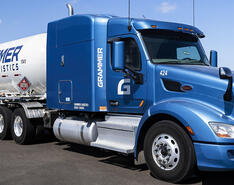
One could argue that the world has evolved from the Information Age to the era of Big Data. In virtually every aspect of the autogas fueling business, the freshest, most comprehensive data helps increase efficiencies, and — more importantly — curtail costs.
But in the realm of propane autogas vehicles, where do those key data points originate? Just ask John Hutchison, director of operations for Prism Propane in North Baltimore, Ohio. His company works with six school bus customers, each with their own autogas refueling station except one, which comes to Prism’s facility to fuel. Customers with their own fueling stations generate data at the pump through the autogas dispenser they use to fuel.
“What our customers like is that they can track who and what is being filled,” Hutchison said, referring to Superior Energy Systems’ PRO-Vend family of autogas dispensers. “They can take some of the error out of the bus driver tracking the gallons and mileage when they are filling. The system also eliminates paperwork. They can easily pull a report from the cloud-based system, for one week, a month or a year to gather information for whatever data they are seeking.”
Generating Data at the Pump
There are a couple of ways to generate data at the autogas pump. One is through third-party fuel management, but the challenge there is ensuring the interface actually works, in order to cull the data to make accurate decisions and predictions. It can also require additional costly hardware.
The more effective way is through embedded, cloud-based software in a system designed specifically for management of autogas fleets as diverse as transit buses, work trucks and school buses, like Hutchison’s customers.
In the case of the PRO-Vend line of dispensers, a touchscreen interface on each stainless-steel-cabinet dispenser makes fueling simpler because drivers can initiate a fill with a key fob or access number, which minimizes training time, increases efficiency and maximizes uptime.
Behind the scenes, the software logs every transaction, capturing critical data like driver and vehicle identification, odometer readings, gallons pumped and fueling start/end times.
All that data is instantly synced to the cloud, where authorized users, like fleet managers can view, analyze and export reports in real time.
Hutchison said the data that is most important to his school bus fleet customers is the gallons that each vehicle uses. That translates to reduced costs — consider that the cost of a gallon of propane autogas fuel is about 50% less than an equivalent gallon of diesel. A report that shows the comparison helps make the case that propane buses are the more cost-effective route for school districts and school bus contractors.
The fact that propane buses cost about a third of an electric bus and require less costly refueling infrastructure than electric as well as significantly lower emissions compared to diesel buses is simply icing on the cake.
Using the Data
How is the generated data used?
“The customers that have their own filling station with the capability of the PRO-Vend dispensers track their mileage and fuel usage — and when to perform their service work,” said Hutchison.
That’s another value of data. No fleet operator wants a broken-down vehicle far from headquarters, especially a school bus full of children. Data generated at the pump, particularly mileage data, can determine when it is time for a vehicle to be serviced, which should reduce the possibility of on-the-road breakdowns. Obviously, nothing can prevent a breakdown from occurring, but the ability of data to predict maintenance cycles can help significantly.
In an industry where uptime is everything, remote diagnostic and software update capabilities allow technicians to access data from anywhere, reducing or even eliminating the need for onsite service calls. Dispensers that receive automatic software updates ensure that every unit in the field benefits from the latest software features and security patches. The PRO-Vend line of dispensers has a built-in map feature that allows fleet operators to locate every fueling site within their network and drill down to each site’s individual transaction history. That means clicking on any fueling ticket reveals details like employee name, vehicle ID, fuel volume and even exact time stamps.
Fleet operators can also manage their accounts from a comprehensive web interface, where vehicles, employees and customers can be easily added or deleted, along with adjusting pricing without the need for cumbersome onsite updates or extra software.
The Bottom Line for Autogas Fueling
As the demand for alternative fuels like propane autogas continues to rise, dispenser technology is allowing this domestic fuel to compete head-to-head with traditional fuels like diesel and gasoline – not just on cost and emissions, but on convenience, infrastructure and intelligence.
This new breed of autogas dispensers provides a strong opportunity for gallon growth for propane marketers like Hutchison. Working with local fleets — be it transit, work trucks or school buses — to show not only the benefits of autogas, but the data that can be generated at the pump to better manage the fleet, makes the marketer that much more valuable to customers.
Looking for more resources? Consider taking a look at this pamphlet from Superior Energy Systems, which addresses common questions and safety points — a helpful tool that you can share with current and potential fleet customers.


